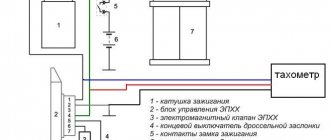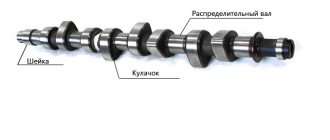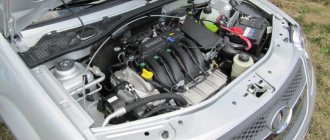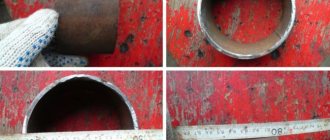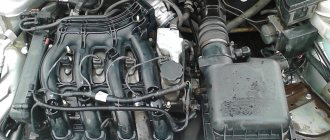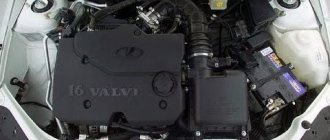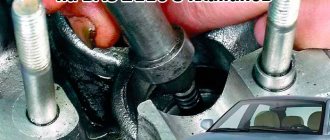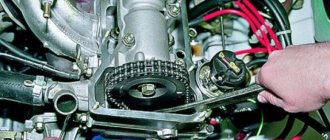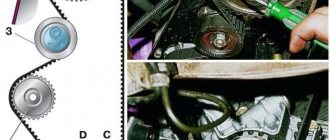Modification of the cylinder head of the VAZ 2109 8 valves
The car 2109 (injector), 1500 cubic meters volume, 8 valves was received for repair. After driving 100 tkm on gas fuel , the compression in cylinder 2 dropped ( 4 atm ). Diagnostics indicated a burnt valve. The owner of the car decided to repair the cylinder head (cylinder head) and install a DynaCAMS RS tuning camshaft, produced by OKB Dvigatel (Ufa) . RS54 for serial heads without modifications , with a lift of 10.6 mm . However, our experience in building such heads made it possible to offer the car owner a 2110-RS58 with an 11 mm . The car already had a 4.1 GP, and the characteristics of the Ufa camshafts gave reason to believe that the car would not lose traction at the bottom. They did not carry out a comprehensive modification of the cylinder head, because For the future, the car owner is focused on installing 16- valve head, and the budget was limited, but some improvements were still made, we’ll tell you in more detail later.
The cylinder head was removed. It turned out that the cylinder head gasket began to lose its seal between cylinders 2 and 3 - gases had already begun to “flow” under the gasket, after 100 tkm the head “moved” a little in the middle part - a common picture for a VAZ 8 valve. Corrected by milling the head plane. The reason for the drop in compression was also found - the exhaust valve plate of cylinder 2 was cracked.
The exhaust valve guide bushings were critically worn. The exhaust valves have a lot of play in their bushings. In addition, on the burnt-out valve, the seating belt with the oil scraper cap broke off from the guide bushing. All valve stem seals were stiff, and the wear on the valve stems was significant.
As a modification to the head, the internal diameters of the seats were increased. In practice, this is akin to installing larger valves. Boring of the seats allows you to increase the capacity of the seats, without expensive replacement of seats for large valves, while the dimensions of the valve plates remain as standard. The head channels remained as standard (without modification).
Additionally, work was carried out to change the lubrication scheme of the valve pushers. On the serial head 21083, the pushers are lubricated with oil from the bath (without pressure). We have developed a method for lubricating pushers with oil under pressure. In practice, this is expressed in a significant reduction in mechanical noise from the cylinder head ; the engine runs calmer and quieter, as with hydraulic pushers. The acoustic noise inside the car is noticeably reduced. Mechanical noise from the pushers is due to the gradual wear of the pusher wells and the “cups” themselves - at high mileage such noises cannot be eliminated in principle - there is only one way out - to change the head, because Repairing wells is difficult to implement in practice (high cost). Supplying oil under pressure into the wells reduces wear on cups and wells, as well as camshaft cams, because they receive additional lubrication. Oil under pressure creates an additional “cushion” in the “well-pusher” friction pair, selects gaps, thereby ensuring shock-free operation of the pusher. Of course, the engine is equipped with non-flat RS washers (modified from serial adjusting washers) . Supplying oil under pressure into the wells of the pushers is our know-how, it has been successfully mastered and used on Oka engines, 21102111. The complex system K-POWER lubrication of the pusher with oil under pressure and non-flat RS washers ( the OKB Engine patent ) allows the preparation an engine that runs quieter and more calmly, even compared to a new production engine.
Separately, I would like to say a few words about the components. We ordered valve guides from Moscow from Moscow from Kolbenshmidt (Germany) and valve stem seals from Goetze (Germany) especially for this cylinder head. Kolbenshmidt cast iron guides are the highest quality and longest lasting of all cast iron bushings available on the market. Compared to them, the VAZ or SM guides that have flooded the market are nothing more than a handicraft. Goetze valve stem seals - a recognized standard of quality, at one time they were even installed on the VAZ assembly line until they were replaced by “Reserve” caps. Camshaft oil seal – Victor Reinz (Germany). The timing and alternator belts were replaced with PowerGrip and Dayco . But the tension roller was left by Vologodsky, VBF . It is difficult to buy a high-quality roller (a normal Gates roller ordered from Moscow costs at least 400-500 rubles ), most rollers sold in stores have broken geometry and after installation they begin to wear out the timing belt. Factory VBFs XADO repair lubricant . Xado technology really works in a wide variety of bearings, as we have already repeatedly seen (but we do not recommend using XADO in gearboxes). After the roller is restored using Hado technology , the bearing play disappears, the noise decreases, and the roller works better and lasts longer than a new one. With the same success, Hado repair technology is used in generator bearings. On this machine, the generator was disassembled, the rear bearing was repaired using Hado technology, and the front bearing was replaced with a new one. The generator immediately “calmed down.”
, a DynaCAMS 2110-RS58 with an intake valve lift of 11 mm was installed . To ensure normal operation of the camshaft with such a lift in the serial cylinder head without breaking the valve springs, modified upper spring plates were used. The camshaft was specially ordered with a slightly reduced cam base, since the seats on the cylinder head sagged naturally due to the engine running on gas. , lightweight T-valves were installed . The valve disc profile with a recess allows to significantly reduce the weight of the valve compared to serial ones. A set of such valves allows the engine to breathe better at high speeds, increases engine power and throttle response. The cylinder head plane was milled. The compression ratio was slightly increased relative to the production engine.
It turned out that the car was equipped with one of the first versions of the ECU. The engine control unit was replaced on January 5, after which the “brain” was reflashed, taking into account the installation of a tuning camshaft. In addition, the engine was equipped with a GREEN . The gas equipment was removed from the vehicle. In addition, the car has a direct-flow muffler can.
Konstantin (Naberezhnye Chelny) approached us with the desire to modify the engine head of a VAZ 2111 (VAZ 2114 car) and install a tuning camshaft from the DynaCAMS line. Briefly about the engine. Engine 2111, volume 1.5 liters, injector (phased injection). Previously, the catalyst was removed, and chip tuning was done at some service (we'll tell you the details later). The motor is in excellent condition.After much deliberation (choosing between 49, 54 and 58 shafts), Konstantin decided to try installing a DynaCAMS 26 with a 9.6 mm lift. Technical specifications for the camshaft can be found here. The camshaft has narrower phases than the serial one, and the lifts are slightly higher than the serial one. The choice of this shaft was inspired by the famous work using the RS49 shaft on a carburetor car. However, it is more difficult to achieve comparable results from an injector, so there was a high risk of “flying over” with the choice of shaft on this particular engine. Moreover, on 26th shaft there has still been no information on the results of its use. It was not so much the roller that had to “take out” the result, but the head. It was the modification of the head and boring of the carburetor that made it possible to open the 49th shaft and achieve such high performance. In this case, narrow phases and small lifts of the 26 shaft should have given good lows and mids, and modification of the head should have revealed the motor at the top. This is according to preliminary estimates.
The head was prepared as follows: the channels were left as standard, without boring or modification. The main focus is on the valve gap. The seats were bored to the inside diameter, which is equivalent to installing larger valves. This type of work has been used many times before and has shown good results. Machines with standard channels and bored seat necks can be seen in the examples: one, two, three. The valves are lightweight and modified. The closest attention is paid to the combustion chamber. It was modified in a special way, improving filling and purging at high speeds.
Set contents:
Camshaft 2111 DynaCAMS 26 with a lift of 9.6 mm Serial channels, seats and channel necks are bored to the inner diameter Alloy spring plates (spring release 1.5 mm) Modified combustion chambers Lightweight and modified valves of serial size 37x31 Guide bushings, special brass, imported blanks Forced valve lifter lubrication Imported valve cotters (high quality steel and machining) Split gear
A small photo report:
Subjectively, the cams of the 26th are even sharper than those of the serial camshaft. The roller was used 2111, with a pin for the phase sensor. The base diameter of the cams is slightly reduced - 37 mm, this makes it more convenient to work with the cylinder head.
By the way, the engine is not “plug-in”; the valves do not reach the pistons, even despite the head being milled. Although there is no goal to create a “plug-in” motor - when using high-quality belts, if you do not overtighten the belt, which many people do, there are no problems in operating “plug-in” engines with high camshafts.
After starting the engine, we measured the graph (there was a measurement before installation, of course). Here a problem arose - the motor did not react at all to the installation of the head and shaft. They added a little here and there, a little at a time. But it was thought that the previous chip would swallow this camshaft, the lambda probe would smell the lean mixture and the ECU would tighten the adjustments. But that did not happen. There were doubts about the camshaft, but the head should have pulled out anything. What's the matter? We started digging... We noticed that the “Check Engine” light did not light up under any conditions. We tried to turn off the mass air flow sensor - zero emotions. What did previous chip tuners do? I had to send the car to a professional colleague for chipping. It was then that it turned out that the left “Khryunov” firmware was loaded, in which EVERYTHING was disabled - the lambda probe, mass air flow sensor, knock sensor, phase sensor . How can the ECU correct anything about the mixture if its eyes have been ripped out and its nose plugged? That's why there were no changes and the car didn't drive any better. This is how chip tuning happens... After working with the firmware (all sensors were turned on, of course) and running and editing the program directly on the road, the car finally drove. Konstantin stopped by again to measure the VSKh.
Let's look at the graphs. Next is the schedule of the machine before all work is carried out. There is no catalyst, the chip was previously done at some “service” (all sensors were turned off!). The engine shows 85 hp. at 5300 rpm, maximum torque 13.6 kg at 3300 rpm . The red line is power, the blue line is torque.
We omit the measurement graphs without normal chipping and immediately move on to the final graph after running the program. Engine power - 96 hp. at 5300 rpm , torque - 14.3 kg at 4300 rpm . It is noteworthy that the maximum power speed has not changed and has not crawled up the revolutions - previously the peak power was at 5300 rpm, and now it’s the same.
Let's superimpose both graphs on top of each other and compare the changes (the dotted line is the final graph). At 6000 rpm 18.8 hp were added. and 2.2 kg of torque. The increase comes from the very bottom - from 2000 rpm. At 2000 rpm, 0.7 kg of torque was added. The character of the motor is smooth.
In conclusion, it is worth noting the following. It is advisable to modify the head for any camshaft; even with a 26 shaft the engine opens better in the upper speed range. The serial head gives unsatisfactory filling at the top. You should be more careful when chipping, you need to find out reliable information on the firmware being uploaded, and not use firmware where all sensors are completely disabled.
Is 26th shaft downstream? I wouldn't say that. Yes, from 2000 rpm there is an increase, but the bottom is given by the cubic capacity, the engine displacement. Head and camshafts - improves the middle and top speeds (unless of course the engine is strangled by the shaft and head, as on the Chevy Niva). In general, this is a good alternative to a standard camshaft, a good option for moderate tuning when you want to keep the bottom, but add something in the middle and at the top, i.e. revive the 8-valve engine without radically changing its character.
Update dated October 22, 2009:
At the request of the car owner, we are publishing a comparison of the VSH of a 96-horsepower engine with a 26-shaft (intake cam lift 9.6 mm) with a serial VAZ 2110 engine. Graphs of a serial engine: blue line - torque, red - power. The graphs of the modified engine are shown with a dotted line. For reference: the production engine of the VAZ 2110 (1.5i) showed 74 hp in measurements. at 5400 rpm, torque 10.9 kg at 4600 rpm.
Konstantin, the owner of the car, also sent feedback on fuel consumption:
Here is the fuel consumption report:
During these 2 weeks we managed to collect some statistics on fuel consumption. With very quiet driving around the city, consumption was 6.3 l/100 km . With a mixed driving style (sometimes sharp accelerations up to 5-6 thousand), consumption rises to 7.8 l/100 km . If I change my driving style to aggressive (I’m always the first to leave a traffic light), the consumption is 9-10 l/100 km . When driving evenly at a speed of 100 km/h, the consumption is 5 l./100 km . I'm pleased with the result, but I don't want to stop there. Thank you, Artem, for the quality work!
Best regards, Konstantin. 20.10.09
Article written: October 4, 2009 Author of the article, photo-video materials: © Quasar Prohibited without the written permission of the author: reprinting the article in whole or in part, reprinting and use of photo-video materials, as well as their modification and editing for the purpose of further publication on third parties sites.
